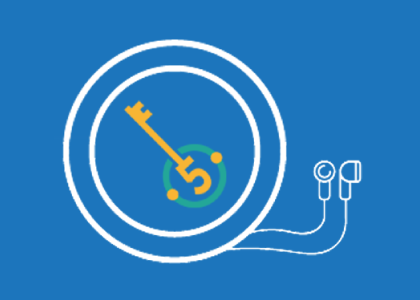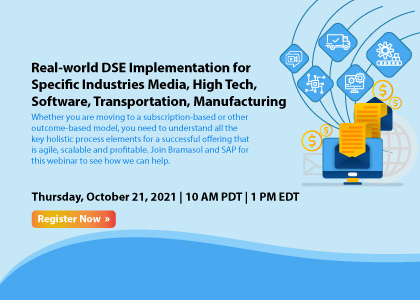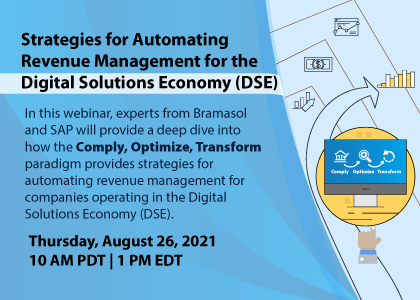Pete Graham: We’re seeing all these use cases amplified by the economic stresses of the pandemic. Especially with the need to adapt to these rapid business climate changes, which are really the shocks. Now we have inflation. All of this has been brought on by a lot of strong eCommerce growth from the COVID 19 pandemic. So, of course, business is always evolving and, in response to these business challenges, many customers are reporting implementing, or the desire to implement new business models, such as offering their products as services or subscriptions. So today that’s what we want focus on.
So we’ve seen a lot of things in the Digital Solutions Economy, but based on our customer feedback the Anything-as-a-Service business model, sometimes called Everything-as-a-Service, is the one that has come to the forefront.
Interesting history, this Anything-as-a-Service model evolved about a decade ago from the technology space and these Anything-as-a-Service business models have been talked about since that time, especially in Software-as-a- Service or Platform-as-a-Service. But now the most common ones that I’ve heard of from customers really in all industries with this Anything-as-a-Service.
Perhaps it’s helpful for the audience to have a use case, and that’s probably the smartphone, right? Which everyone is familiar with. You have a phone, which is the device that has a recurring service charge for data usage. And even the device itself, which is kind of paid as you go with a lot of telcos now, where you can buy the phone and bring it, or you can pay for the hardware as you go.
All this can be combined into a single monthly service fee and a lot of customers like that. So we’re seeing this Anything-as-a-Service now with many different products and services across different industries. I’ve seen car subscription services, obviously you’ve got cloud storage services, such as uploading your photos to the cloud, or Delivery-as-a-Service like GrubHub, and gaming as a service. My kids like the online gaming. So, I think the benefits for the Anything-as-a-Service model are quite interesting. And, they’re kind of simple in the sense that, it’s so quick to get access to this product of service, if it’s consumed this way. So that helps the consumability of the service, right. It’s very easy and flexible so it spreads some of the cost upfront out over time. So it makes it more affordable.
Jim Hunt: Thanks, Pete. That’s a great overview. You mentioned the car subscription services. I noticed that a lot of car manufacturers now are reporting that as a significant revenue stream, because they’ve realized that selling a car once is the old model, but charging for the subscription services on an ongoing is the new model.
Pete Graham: Yeah. And I think that will continue to evolve. Right.
Jim Hunt: Exactly. So let’s jump into what are the key challenges companies face with Anything-as-a-Service?
Pete Graham: I think that’s a really good question. If you are a company that’s not in the technology space, this might seem daunting. So you are going to face several challenges. First. You need to have both the operational and financial capabilities to launch a new business model for which Anything-as-a-Service is the most popular these days. So capabilities like issuing orders, to billing and invoicing, to managing and tracking the fulfillment of those orders, to managing potential usage related to those orders. Then you have the kind of follow up or in-parallel items of calculating the financials and revenue recognition, and analytics. So, that’s kind of like the table stakes or the bread and butter, but then you have to keep up with those new business models in real time to be able to track their progress and handle customer service in real time. All these things are evolving very quickly and customers expect to have kind of real time updates to their service.
Jim Hunt: Let’s drill down a little deeper into what’s needed to have success with anything as a service?
Pete Graham: Sure. So when introducing a new business model, I think companies need to have both the operational and financial capabilities to both launch and track the Anything-as-a-Service. So, maybe it’s helpful to walk through an example of introducing a new business model. In this case, let’s assume that it’s a hardware device with usage as a service. So, many companies have devices that they sell a product. So this new model would have the following elements where you have the device and then you have a subscription, which could be for the pieces, or a lot of times it’s all assembled into one bill every month. So there’s a little flexibility there depending on the exact company and their needs. So again, you have the device, the subscription, and then we’ll add activation potentially for the device, then the usage from the device.
Pete Graham: And of course, then you have the elements of managing it, right? Whether it’s the revenue accounting and financials and analytics, as well as the operations. So if you look at the process steps across these elements, you’d have things like the initial order. Then you’d have maybe a first billing and maybe there’s a first month activation fee. Then there would be hardware, fulfillment and hardware billing then usage, and then you’d have a second billing that potentially would keep recurring as you are using that device. So, from a practical perspective, these companies need a way to operationalize these new business models, right? Being able to quickly provide the elements that we talked about, like orders, billing, invoicing and fulfillment to their end customers. And then once that operational box is checked, the companies then need to focus and have the financial insights and the transparency to then manage the progress and success of these business models in a real time basis, day to day.
Jim Hunt: Yes. And as we’ve talked about before in other sessions, all of the things you just described operationally, they need to happen essentially behind the scenes where you give a more simplified and easy to navigate version to the customer themselves.
Pete Graham: Yeah, exactly.
Jim Hunt: Pretty tall order.
Pete Graham: Yes, It is.
Jim Hunt: Let’s talk a little bit about how the SAP ecosystem helps solve that tall order and implement Anything-as-a-Service holistically.
Pete Graham: Sure. The holistic solution from SAP that addresses Anything-as-a-Service is SAP’s S/4HANA, which is the intelligent ERP that powers your modern finance and risk platform. And it can accelerate finance into the digital age by providing the agility, the analytics, the assurance and the automation. So with S/4HANA Finance, you’re free to grow and adapt as you see fit, including these new business models, so you gain an exhaustive view of your business. Whenever you need to take a decision, you have it, and you have the power to act instantly and immediately on the insights that you can glean.
A key benefit is for your finance application in S/4HANA to access the same repository, which we call the Universal Journal. So this is your single source of truth. And it uniquely combines the transactional and analytical data in one in memory computing system, so you can accelerate your decisions based on real time data-driven insights at the point of action. Also S/4HANA allows you to adapt to this new business model challenge by providing the capabilities for quotes, orders, billing, invoicing, fulfillment, automated revenue management reporting, and all in one place. And it’s all interoperable. SAP’s S/4HANA intelligent finance can also help you implement and gain insights into Anything-as-a-Service business model. So really this is the tool that allows you to have this robust business model adoption, including Anything-as-a-Service and other subscription and consumption based revenue models that we talked about briefly earlier.
Jim Hunt: Perfect. Let’s take a little bit of time and drill down, both operationally and then financials and analytics. Let’s take operationally first. How can SAP help companies address their operational issues specifically?
Pete Graham: Sure. And I think that’s the right way to look at it. You kind of break it up into some pieces and the first piece is operationally you have to be able to execute on that business model or whatever the request is. Right. Typically you’re going to have to manage things like the sales order, the subscription contract, the billing, which BRIM module would handle, plus the outbound delivery, the goods issue and movement, and even invoicing, which some of our SAP customers might look to FI-CA for. So SAP provides the line processes for all these operational streams. Drilling a little bit more into Billing and Revenue Innovation Management, which is BRIM, this actually had its roots in the utility industry. So, your utility bill has been a service for a long time. And, I remember early on in my career people were kind of thinking about, when do I get the utility for computing? Well, that’s now here, right? So you now have these supporting subscription and consumption based models used for many years on the BRIM side, which are now so much part of today’s Anything-as-a-Service business models.
Jim Hunt: Yeah. And for some of those like utilities and phones you mentioned earlier, the scale of how many bills they send is huge.
Pete Graham: Yeah. exactly.
Jim Hunt: Right. So, so given that, if you’ve got the operational steps in place, let’s take a look at specifically how SAP can help deal with financials and analytics.
Pete Graham: Sure. So, the first piece is that SAP S4/HANA provides the seamless financials, right? So it has all those parts and they’re all built in, including the financials. Part of it is also, it has a revenue recognition module. So, you can also automate and simplify the key pain points of many financial close processes. Also the revenue accounting can be decoupled from the billing, or it can be coupled. That’s a really nice, flexible part of the S/4HANA system that allows for the flexible business models. It’s up to the customer to choose which way they want to implement it, and S/4HANA can support it. Also, S/4HANA also can support multiple accounting principles for revenue recognition if you need it. And we do have customers operating around the world that need that.
Pete Graham: Additionally, the RevRec is calculated on the fly in parallel while the operational processes, such as the orders and billing fulfillment are being executed. So, it’s almost having your cake and eating it to, in that you’re handling the operational side and all along in parallel in the background, all of the financials, revenue recognition, and embedded analytics are providing immediate, intelligent insights into the key financial information and financial metrics that are built right into the Universal Journal and are all made available to the business and the finance folks. So they can better manage their operations.
Jim Hunt: So there’s none of that standalone RevRec software or offline spreadsheets or anything like that, where you have to massage the data and integrate it?
Pete Graham: Yeah, you don’t. It’s all integrated, it’s all interoperable. And you can toss those spreadsheets away.
Jim Hunt: That’s great. I bet a lot of people just cheered when they heard you say that! So what should companies be doing now to get ready for Anything-as-a-Service?
Pete Graham: Yeah, I think if you don’t already have a service like this, Anything-as-a-Service or subscription service at your company, you probably will very soon. This has become just a wave that you’re seeing it everywhere. So I would probably take a step back and really take an inventory of your operational and financial and analytics systems. Right. Are they flexible enough to handle these new business models? Are they decoupled for instance, between the billing and the RevRec capabilities? Is the order-to-cash cycle fully interoperable, or do you have to build some links? Then you need to look at the capabilities of real time and how much data can this consume. Because as we talked about in the utility example there can be millions, of transactions.
I mean, imagine some of the companies out there with digital operations, and internet of things and things like that. The data is gong to be probably in the billions soon, right? So you need to be able to consume large amounts of data inbound or outbound and without running batches. Because, if you’re running a batch system, it’s going to make adopting these new business models much more difficult from the operational financial side. Additionally are there insights from the financial side in analytics? Are they immediate? Are they connected and interoperable? Or do you need to have batch processes run to connect these things? So all those things you need to take into account. The good news here is doing this inventory assessment is not insurmountable. This is something that partner like Bramasol that’s skilled in this area can help customers with.
Jim Hunt: Great. Before we jump to a summary, I just wanted to expand on something you said when you talked aboutthe internet of things. For example, I use the Mirror, and it collects all this data on when I do exercise sessions or meditation sessions. And there’s just a ton of data being generated by those devices and, although the users may not think about it, the providers have to deal with it.
Pete Graham: Yes, they have to consume it, sort through it, then, you know, as my kids, they apply AI to it.
Jim Hunt: Your kids sound brilliant.
Pete Graham: Yes.
Jim Hunt: In summary, are there any words of wisdom, or a wrap-up that you’d like to add?
Pete Graham: I think probably the simplest thing is just to quickly list the benefits of SAP’s S/4HANAN intelligent finance when you are trying to tackle these new business models. So we we’ve seen, it really has the capabilities to help companies enable robust business model adoption. The system is flexible. You can be de-coupled between the operational sales billing and revenue recognition. You are real time in nature. You’ve got optimized processing and operations for revenue management and other financial information, whether it’s inbound or outbound and you have embedded analytics. So you’re able to get key financial insights immediately.
Jim Hunt: That’s a great wrap up. Thank you, Pete. You really packed a lot into 20 minutes and I know the listeners will really appreciate it. I know I learned a lot. Thank you again.
Pete Graham: No problem, Jim. Thanks. Have a great day.



